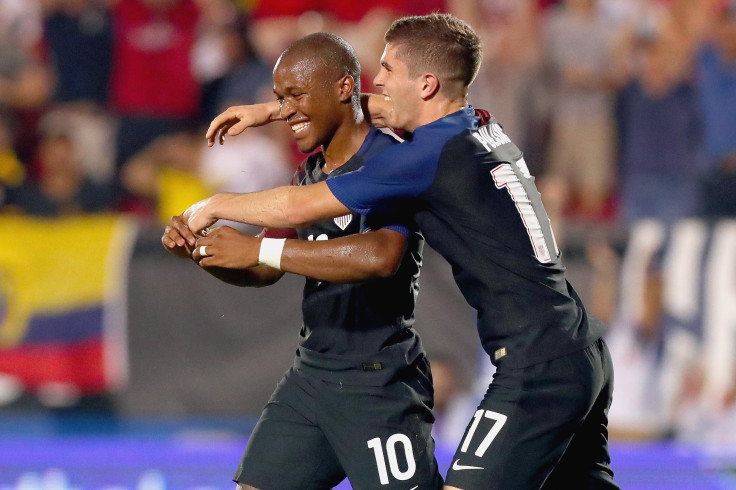US Soccer Team: 3 Big Reasons For Optimism After Argentina 2016 Copa America Loss

If it had been predicted before the Copa America Centenario that the U.S. men’s national team would reach the semifinals before bowing out to the world’s No. 1-ranked team, few involved in U.S. soccer would have balked at the idea. But there is no escaping the fact that the way the U.S. team exited at the hand of Argentina has left a bitter tinge of disappointment.
It ’s likely that Lionel Messi and co. would have dispensed with the U.S. regardless of the Americans’ efforts. But to give up a goal from a short corner inside three minutes and to fail to have a single shot at goal through the 90 minutes of a 4-0 defeat was indicative of a team that failed to maximize its chances. From Klinsmann’s questionable lineup and tactical decisions to sloppy turnovers, there is a lot to think about for the U.S. going forward, even with the formalities of a third-place match Saturday. But as a U.S. fan, there are also reasons to be optimistic as the team looks to reach its eighth consecutive World Cup. Here’s three of them.
Christian Pulisic and Darlington Nagbe
One of the most frustrating aspects of the United States’ performance against Argentina was that the two players to have really emerged from the senior national team program in the past few months were not given a chance to start. With suspension ruling out three players, Klinsmann elected instead to bring in three players with a combined age of 95. Neither Chris Wondolowski, Kyle Beckerman nor Graham Zusi excelled, and it’s hard not to think that the U.S. would have had a better chance of keeping some possession and posing a threat on the counterattack if Christian Pulisic and Darlington Nagbe had been involved.
Klinsmann appeared to acknowledge that when bringing on Pulisic for Wondolowski at halftime. While unable to alter the course of the match, in the second half, the 17-year-old Pennsylvania native showed sparks of his rare talent. There should not have been many doubts about Pulisic’s ability to handle the magnitude of the occasion, given how he has performed in his breakout season with Borussia Dortmund.
Nagbe does not have the same prodigious talent, and, at 25, is far from a young prospect. But on the international stage, the Liberian-born player — who received U.S. citizenship last fall — is a newcomer. Capable of keeping the ball and linking up with the forward players, Nagbe possesses qualities not found in abundance among American midfielders. Both Nagbe and Pulisic should feature in the third-place game and going forward if Klinsmann is to start meeting his objective of playing more proactive soccer.
John Brooks
The big positive of the Copa America for the United States was the emergence of John Brooks, a player who looks like he could be the bedrock of U.S. defense for the next decade. The 23-year-old’s potential has been there for some time, and it’s now almost three years since he made his U.S. debut. But though he is probably still best-known for his last-gasp headed winner against Ghana in his team’s opening game of the 2014 World Cup, it has taken time to mature.
At last summer’s Gold Cup, his partnership with Ventura Alvarado was a major weakness for the U.S. as it crashed out at the semifinals. Yet, helped by the presence of a consistent, reliable partner in Geoff Cameron, the Berlin-born player hardly put a foot wrong, both in the Copa America and in the lead-up matches. With all the necessary physical tools, the lackadaisical errors that once blighted his game now appear a thing of the past. It is no surprise that there is rumored interest from the English Premier League to take him away from Hertha Berlin this summer.
Klinsmann Learning From Mistakes?
Brooks’ performances were undoubtedly aided by being allowed time to form a partnership with Cameron. That kind of consistency has been sorely lacking from the U.S. in recent games under Klinsmann. All too often, the release of Klinsmann’s starting lineup has been met with a sense of bewilderment. Players have been plucked out of the blue, often to be rapidly discarded (Julian Green, anyone?), as well as being regularly asked to perform out of position.
But at the Copa America, Klinsmann fielded the same starting lineup for three consecutive games for the first time in his five-year tenure. The positive results were there for all to see. The U.S. rebounded from an opening loss to show unity in delivering in two must-win games against Costa Rica and Paraguay before suspensions kicked in to disrupt matters in the knockout rounds.
There is a value in experimenting and discovering new talent in between World Cups, but it is also critical to have a core group that is familiar with its teammates and its system. Hopefully for U.S. fans, that conclusion is one of Klinsmann’s major takeaways from a Copa America in which his team ultimately delivered on his objective: to reach the semifinals.
© Copyright IBTimes 2024. All rights reserved.











